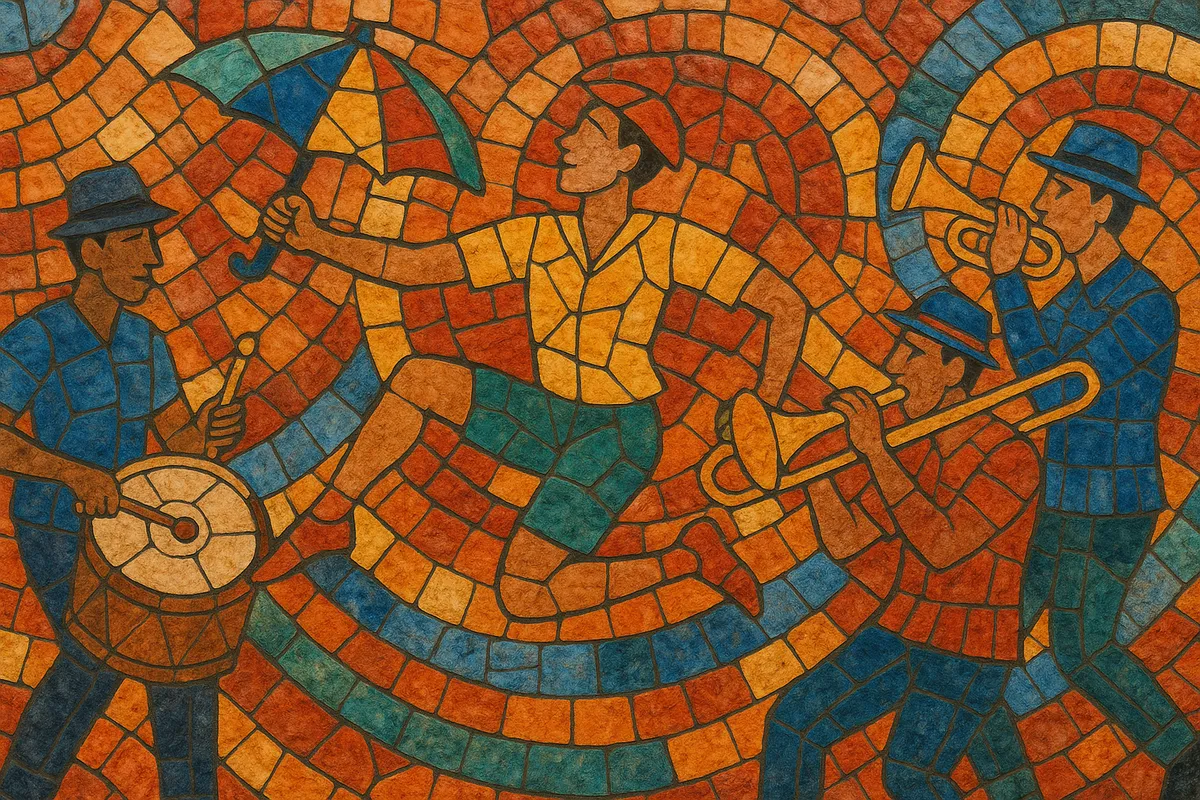Frevo is a fast, brass-driven carnival music from Pernambuco, Brazil, especially associated with the cities of Recife and Olinda. It is characterized by dazzling, syncopated melodies, staccato horn lines, and relentless 2/4 rhythmic propulsion that inspires acrobatic dance steps performed by passistas with small, colorful umbrellas.
The genre encompasses several substyles: Frevo de Rua (instrumental, brass-band led), Frevo de Bloco (choral/string-led, often more lyrical), Frevo-Canção (song form with solo vocals), and Frevo Elétrico (amplified, trio-elétrico format). In 2012, frevo was inscribed by UNESCO as Intangible Cultural Heritage, underscoring its deep cultural significance to Brazil’s carnival traditions.
Frevo emerged in Recife at the turn of the 20th century, growing out of the intense street-carnival scene where military and civic brass bands competed for attention. Musically, it fused European-derived marches (dobrado) and dance forms such as the polka and schottische with Brazilian urban idioms like maxixe and choro. The word “frevo” is popularly linked to the Portuguese verb “ferver” (to boil), capturing the music’s boiling energy and the heated rivalry of bands and dance troupes.
By the 1920s and 1930s, frevo’s instrumental, horn-led format (Frevo de Rua) dominated Recife’s carnival streets. Soon, Frevo de Bloco emerged, featuring women’s choirs and string ensembles, and Frevo-Canção introduced vocal frevos structured as strophic songs for radio and records. Composers such as Nelson Ferreira and Capiba standardized forms, harmonic language, and a repertoire that became staples of Pernambuco’s carnival.
In the 1950s, frevo’s rhythmic drive was adapted to amplified trio-elétrico ensembles in Bahia, giving rise to Frevo Elétrico and laying essential groundwork for later axé music. Meanwhile, Recife maintained powerful brass traditions through municipal bands and carnival organizations, with singers like Claudionor Germano popularizing frevo-canções on radio and LP.
From the 1990s onward, orchestras such as SpokFrevo Orquestra and the Orquestra Popular do Recife refreshed the idiom with sophisticated arrangements that bridged concert stages and carnival streets. In 2012, UNESCO recognized frevo as Intangible Cultural Heritage. Today, mass carnival blocs like Galo da Madrugada keep frevo central to Pernambuco’s identity, while contemporary arrangers and performers continue to expand its technical and expressive possibilities.
Write in a brisk 2/4 with an urgent, marching propulsion. Tempos are typically very fast (often 160–200+ BPM). Maintain continuous forward motion with strong upbeats and syncopations to create the signature, "boiling" drive.
Center the arrangement on a brass/reed band: trumpets, trombones, saxophones (alto/tenor), with clarinets, tuba/sousaphone, and occasional flute/piccolo for brilliance. The rhythm core is snare (tarol/caixa), bass drum, cymbals, and surdo. For Frevo de Bloco, add strings (guitars, cavaquinho, violins) and choir; for Frevo-Canção, feature a lead vocalist; for Frevo Elétrico, use electric guitars, bass, and trio-elétrico amplification.
Compose short, incisive melodic cells that leap and twist through diatonic scales with chromatic passing tones. Use bright major keys and frequent secondary dominants; modulate to closely related keys (e.g., the dominant) for lift. Write antiphonal lines between trumpets and saxes, and punctuate phrases with tight brass hits and rapid unison runs.
Keep the snare busy with accented offbeats and rudimental figures; let cymbals mark bright crashes on strong beats. Brass parts should be staccato, articulated, and agile. Avoid long sustained notes; favor perpetual motion in inner voices to sustain intensity.
Common forms include ABA or through-composed sequences of 8–16 bar sections. Build tension by modulating and by increasing density (countermelodies, octave doubling). End sections with triumphant cadences, drum breaks, or tutti stingers that suit parade performance.
Write with the passista in mind: sharp accents and breaks cue acrobatic steps (influenced historically by capoeira) and umbrella flourishes. On stage or in the street, prioritize clarity of cueing and balance so dancers can lock into the rhythm.


